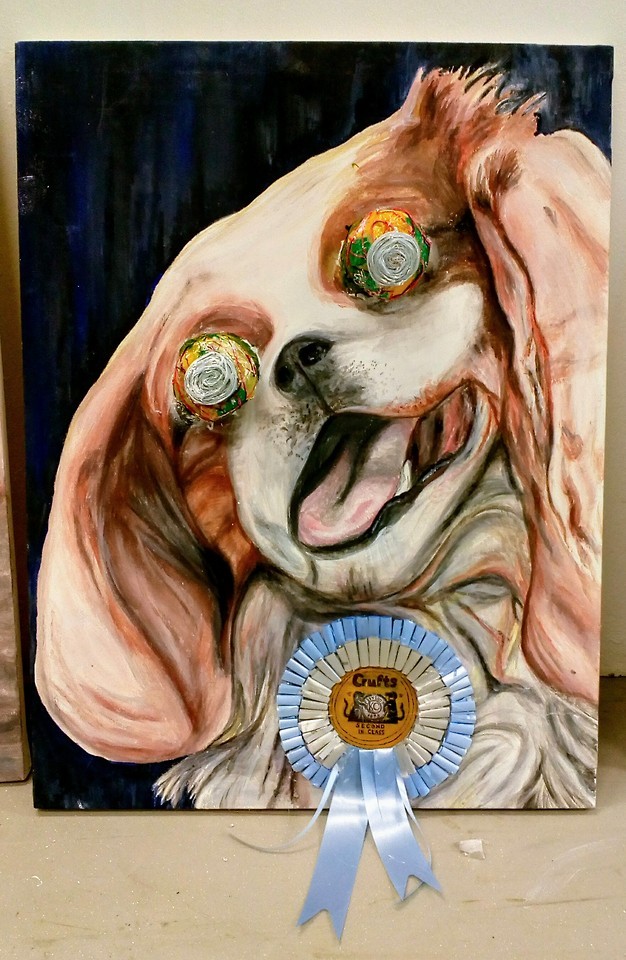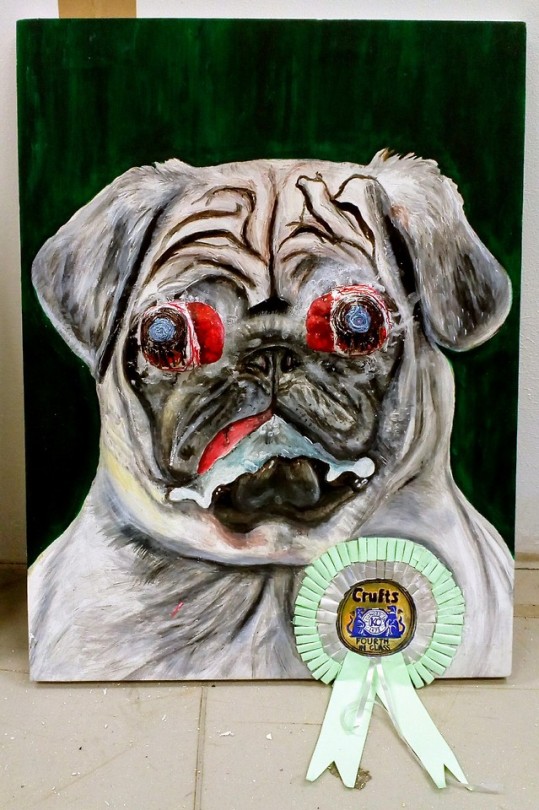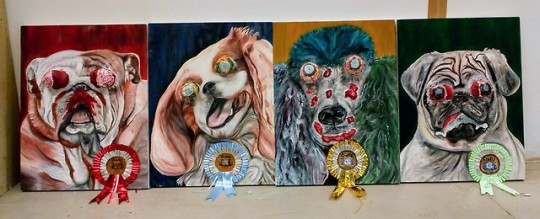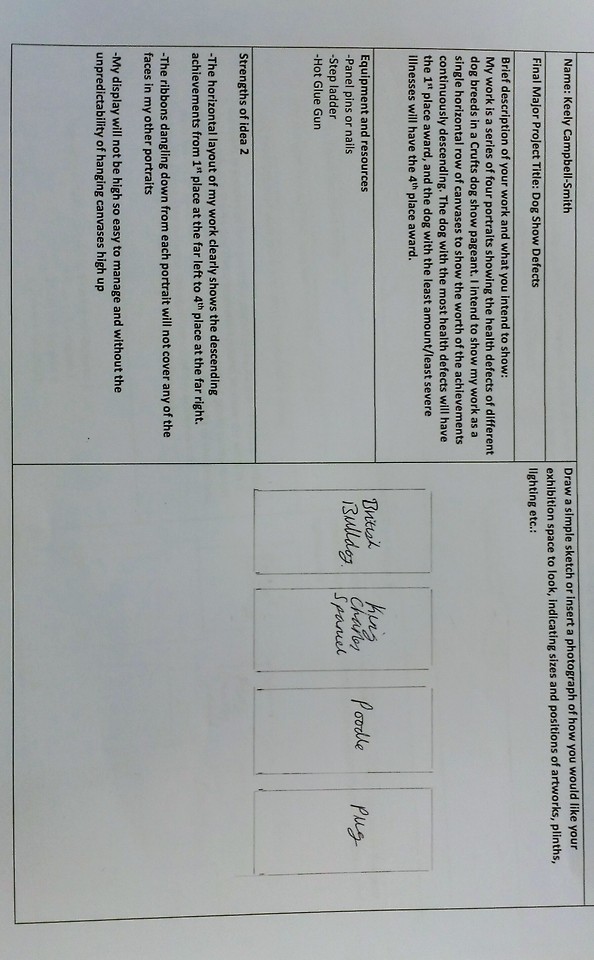Text

I based this multi-media piece on Theophile Steinlen’s 1896 poster ‘Le Chat Noir’. I added ancient Egyptian styles and art-nouveau inspired colour and arrangement to this piece to form a new reinterpretation of this classic nineteenth-century poster.
0 notes
Text
Evaluation of Final Outcome
My overall theme of ‘Dog Breeding’ differs greatly to what I initially thought I would base my work on. I initially thought that ‘Animal Rights’ would inspire me to create work on farm animals and use the abattoir as a setting for my work as that is where the most violence and loss of life occurs in animal related industries. Instead, I wanted to focus on an issue that does not as obviously link to animal rights and that as far as I know has not been covered by artists which is ‘Dog Breeding’. Being inspired by George Orwell’s ‘Animal Farm’, I took the themes of power, vulnerability, business and man-made infliction as opposed to the subject of farms and farm animals. I nave not researched a lot into the theme of ‘family’, a theme that I thought would be prevalent in my work due to its emotive connotations, but instead researched into the themes of health, competition and business. Consequently, my work came to not focus so much on catharsis, but instead to reflect the current dog breeding and dog show issues as awareness. I hadn’t thought about dog shows as ’garish beauty pageants’ or the health problems many pedigree dogs suffer so I felt motivated to research the issues and gain a lot of knowledge from it. I have still used ‘Speciesism’ as an issue subtly in my final piece as my dog show pageant rewards only pedigree dogs: the British Bulldog; King Charles Spaniel; Poodle; and Pug; not mongrel dogs. My research has touched on eugenics and the Aryan race to show similarities between how The Kennel Club sets out criteria for ‘desirable’ characteristics in dog breeds, as did Hitler in Nazi Germany for the ‘perfect’ race;or in The Kennel Club’s case, the ‘Breed Standards’. I have supported my Project Proposal by using both 2D and 3D medias in my final piece, something that I planned on doing in my Project Proposal to create more detail in my work.
In my opinion, all of the research that I gathered for my project was relevant even if it did not link directly to dog breeding. At the start of the project, I kept my research broad into ‘Animal Rights’ generally, so researching animals in entertainment, food, animal testing etc which allowed me to gain a broad insight into the injustices of animal treatment and their vulnerability, being victims to human dominion. My research at that point was mostly from articles or photos on the internet or reading chapters in literature or philosophy books for intellectual insight into the the issue. My research started to focus on dog breeding when i decided that producing artwork on dogs and their rights would be interesting as it is not widely researched so I gained very relevant primary research by visiting the RSPCA in Derby where I learnt about their reasons for being there and their experiences. Only then did I decide that ‘breeding’ would be a fascinating and unique topic to focus. looking at the consequences of overbreeding on dogs quality of life and standard of living. I took many photographs at the location of the dogs which I used in my experimental pieces of work, but the whole experience made me want to create work that exposes the suffering and helplessness of many dogs as I found the experience sad and overwhelming. As a result, this research moved my ideas forward because it inspired and motivated me to research deeply into dog breeding which linked to dog shows, The Kennel Club, Crufts, pedigree dogs and health defects.
One of the main problems when creating my final piece was time management. It took me longer than I expected to finalise my final piece plans as I was still experimenting with ideas and materials. However, what helped enormously was the weekly plans and frequent evaluations that I did which really helped me to organise my timing and preparations for my final piece, especially in the last few weeks of my project where my schedule to get parts of my project completed was hectic. Another problem that I encountered was experimenting with materials at a late stage which was to be used specifically in my final piece that I hadn’t used before. For example, making my own canvases using wood, canvas sheets and emulsion paint, or even combining 2D and 3D pieces in my work which I hadn’t done previously in my experiments. Making the rosettes out of ribbon was part of my final piece that I hadn’t tested out before, therefore I was unsure about whether it would suit my final piece, eventually deciding that it added to its garishness. I resolved making my own canvases from scratch by asking one of my lecturers to give me a tutorial on how to make one which I carefully noted so that the canvases I made were of good quality. I did worry to begin with whether the canvas sheets were stapled tightly enough to the wood, however, I adjusted them by stretching them tighter over the back. I resolved my lack of practice into combining 2D and 3D elements in one piece together by gathering 2D and 3D experimental pieces and roughly positioning them over each other. This was where the thought of adding 3D protruding eyes for each dog came from, and also the thought of using mod rock for skin disorders came from. I also did a little research into artists who use both 2D and 3D elements in their work which made me feel comfortable with what I wanted to produce and the effect that it could give. Overall, I am glad that I did make my own canvases as it feels more personal to me and part of my art, as well of being of better quality than a shop-bought canvas. I am also happy with my combination of 2D and 3D elements in my final piece as I feel it gives a greater grotesqueness and realism to my work.
I played to my speciality of painting for my final piece as I felt that it would overall be of better quality if I did. I think that I developed as a painter when painting my final piece as looking at my overall portraits, (specifically the Bulldog and King Charles Spaniel) the finish on them looks quite professional. I think this is because I learnt to add water to acrylic paint which gave a smoother and more blended finish. Although I did not build on as many skills in painting my work, I did develop many skills in 3D / sculptural pieces of work. I had never made eyeballs out of newspaper, tissue paper and embroidery thread before, nor had I ever made rosettes out of ribbons so in my opinion I have developed greatly in 3D work and in learning how they compliment 2D pieces also. I was experimenting with materials even when I was creating my final piece which was risky as they were to be used in my final piece. Although it could be seen as disorganised, I think that is how I personally work and am confident that my final piece will look accomplished when I have a clear vision of what I want my final piece to include. I worked in this way for the Sudbury Hall project which I felt brought more imagination and creativity to my work. For this project, I didn’t plan to make my own canvases but it has really expanded my practical skills and has added more individuality to my work as they are the exact size that I required and slightly rugged as well which shows they are homemade. I did adapt my work to an extent when considering the experiments I carried out for the final piece, however, timing did make it difficult to change too much of my final piece plan, so I just had to make the best quality work I could out of my current final piece idea.
I think that I managed my time well to begin with in the project as this was the experimental time and the weekly action plans certainly did help me organise the current week and week ahead to get as much work done and supplies gathered as possible. However, despite having the plans later on in the experimental period, I feel that I got a little carried away with experimenting and not planning early for the final piece because there was so much in my research on dog breeding that I still wanted to explore in my art. Nevertheless, I became more strict on time management when I started my final piece as I wanted to make sure my work would not be rushed and be the the best quality possible as I was aware that the size of my final piece was quite ambitious, especially with them being detailed paintings. I used my journal continuously to record the development of my project, however, when my action plan sometimes got quite chaotic, I tended to reflect and develop and organise my work in my head, so forgot to fully evaluate my work at every stage. Nevertheless, I would catch up with the reflections and evaluations in my journal after the chaotic schedule so that all my thoughts and plans were recorded throughout.
Overall, I think that my final outcome is successful in terms of its appearance and effective in conveying the message that I wanted it to. The detail of my work is good as I don’t think I have spent so long on a single piece of work before and so I am very proud with the scale of it and its appearance generally. The 2D and 3D pieces give it an inventiveness that it would not have had without the 3D pieces. I think that the meaning of my work is easily translatable also as it shows the contradiction of ill/ deformed dogs being rewarded in a Crufts show which demonstrates clearly that I am showing the negative aspects of Crufts and dog breeding. Looking at the final work, there is a good balance of grotesqueness, detail and meaning. I wanted to stay clear of creating work that was too gory as I am sensitive to such material and I did not want the meaning of my work to be ignored/ overshadowed by the overwhelming grotesqueness of it. Furthermore, I am a little dissapointed that my last two portraits (the Poodle and the Pug) are not as detailed and have less of a professional appearance then the other two portraits. I think this is because time became an issue and the pressure was getting to me to finish soon at that stage.
Overall, I think that my work has been a success in its appearance, scale and meaning, which will hopefully be supported by the feedback in the exhibition.
1 note
·
View note
Photo

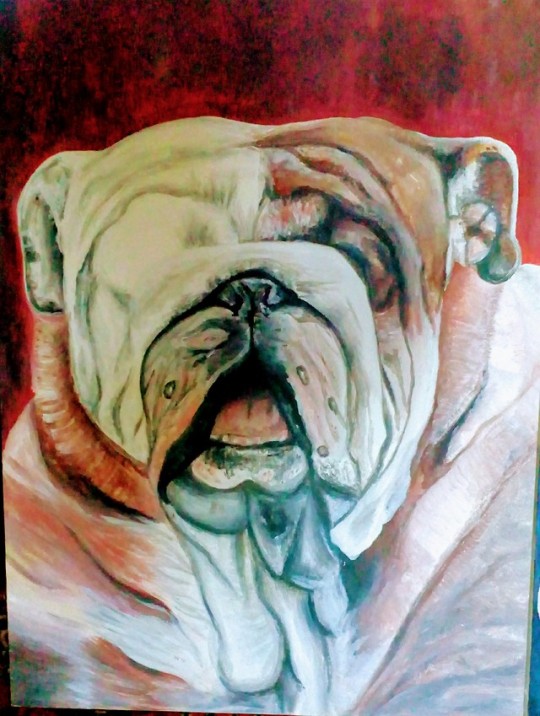
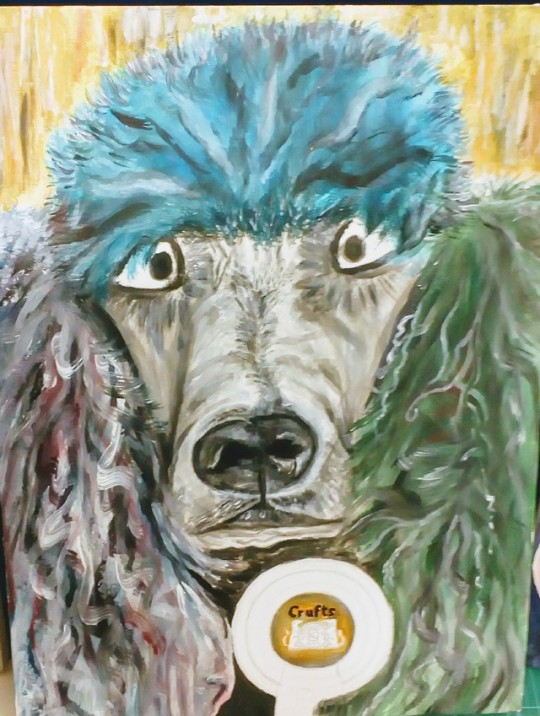

My final piece so far. The paintings are completed, but I have yet to add the 3-D eyeballs and rosettes for each portrait. Painted are the dog breeds: King Charles Spaniel, British Bulldog, Poodle and Pug.
0 notes
Text
Poodle Eye Diseases Research
Eye problems are a primary health issue for poodles.The poodle's endearingly doleful eyes rank high among their most defining physical traits. Unfortunately, the breed is particularly prone to several types of eye problems.
Progressive Retinal Atrophy
Progressive retinal atrophy is a condition caused by several diseases that damage the hidden part of your poodle's eyeballs. Vulnerability to this condition is hereditary, and poodles are one of the breeds that are at high risk for developing it, according to the Poodle Club of America. Unfortunately, there is no way to mitigate or prevent your pet's eventual loss of vision from retinal atrophy. Your dog may be frightened or depressed as he loses his sight, so it's important you keep playing and interacting with him even if it's difficult to coordinate. Your toes are going to get stepped on, but it's worth it to keep his spirits up. Use toys that make a lot of noise to help your dog find them. It's also a good idea to "dog proof" the house, covering or moving dangerous objects with sharp corners that he could collide with accidentally.
Optic Nerve Hypoplasia
Retinal atrophy is not the only hereditary eye problem poodles can develop. The breed is also known to harbor genes that encourage optic nerve hypoplasia, which disrupts and deteriorates ocular activity. This disease can be more vicious or merciful than atrophy, depending how look at it. Rather than slowly losing their sight over time, dogs with hypoplasia are born with full or partial blindness. A dog born partially blind may be better able to adapt to it and learn to use his other senses compared to a one who develops blindness later in life.
Cataracts
Poodles can also develop cataracts just like older humans can. Cataracts look like a layer of semi-transparent film that bends light and distorts your dog's vision. While the development of cataracts is linked to genetics, poodles have a relatively high incident rate; they are also a common result of the natural deterioration that accompanies aging. Your pup may have had healthy eyes all though his adulthood, but that does not mean he won't get cataracts when he becomes a senior. While cataracts can be limited to only one eye, they will often appear in both eventually.
Glaucoma
Glaucoma can also be passed down through your poodle's family tree, although breeders have taken some actions to regulate the propagation of this trait. This condition describes the build-up of fluid in the back of the eye. The fluid applies pressure to the sensitive ocular nerves that connect your dog's eyes with his brain. Over time, this pressure can cause partial or complete blindness. It is recommended that potential poodle owners examine their puppy's parents to ensure good eye health before deciding on a pet. Breeders should test their dog for this condition before breeding them, according to Discovering Poodles. Don't lose hope, though. Unlike some other genetic eye problems, your veterinarian may be able to prescribe medication or recommend surgery to help your dog. Catching the problem early is critical for treating the condition before permanent damage occurs.
0 notes
Photo
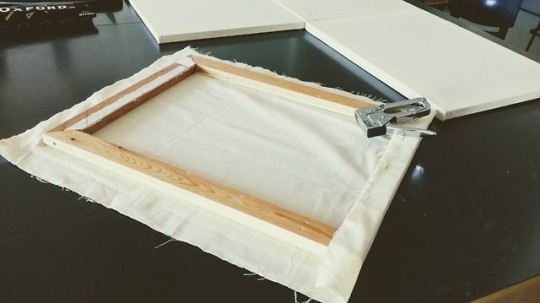








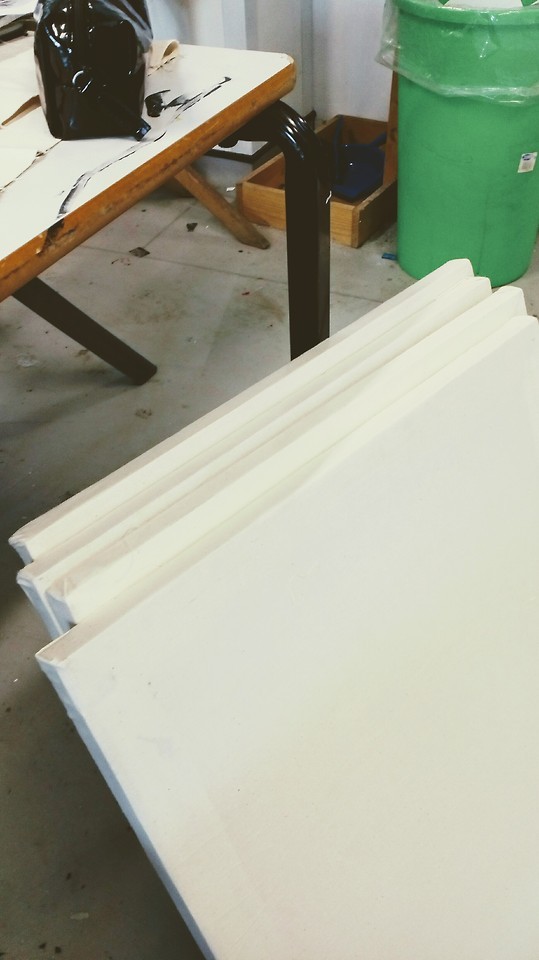
I have started my final piece by creating my own canvases to work on. I am planning on creating four portraits of dogs with health defects, therefore have made four 460mm by 610mm canvases. I asked the technician to make the wooden structure of each canvas to the scale that I wanted, and then I stretched over light-medium canvas sheets over the wooden structures. To secure the canvas over the rectangular structures, I tightly stapled the edges of the canvas sheets to the back of the wood. To create a neat finish, I folded the corners of the sheet over the corners of the wooden structures. The result of this is shown in photograph 3. To create a hard surface on the canvases, I painted each canvas with a thick layer of white emulsion paint ready to painted with acrylic.
Start of my Final Piece.
0 notes
Link
0 notes
Photo

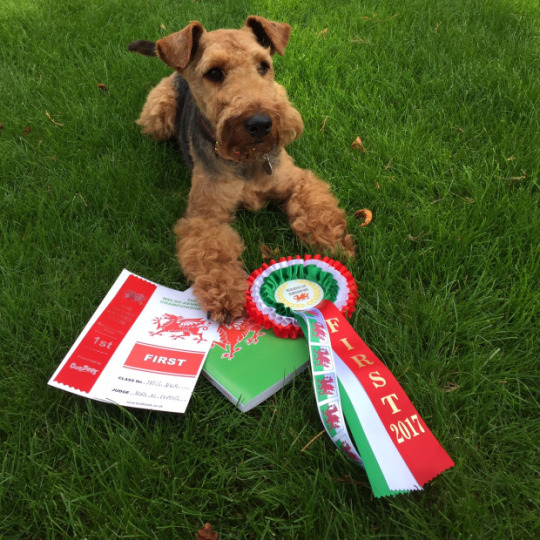

Research into the dog show Crufts for information about the rosettes. I will base the rosettes that I will make on the Crufts rosettes given to 1st, 2nd and 3rd place. However, I may not have time to completely make the rosettes, so if not, I will paint the rosettes onto the canvas instead.
0 notes
Photo

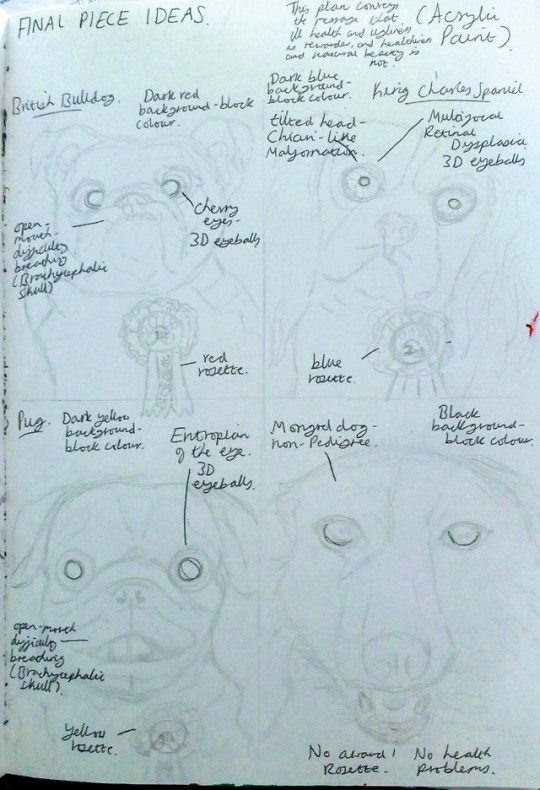
Final Piece Idea plans. I want the four piece Pop-Art inspired layout, however I am still unsure about which dog breeds I want to include and with which health problems. I want the dog in 1st place to have the most health defects as a result of inbreeding and then the dog breed in 4th place to have the least health defects. That way, the message that dog shows reward the most inbred dogs is displayed. Overbreeding and inbreeding is what is carried out to achieve the physical criterias of the Pedigree Breed Standards, but without the consequence of severe health problems.
‘Blur: The Best Of ‘ album cover designed by Julian Opie
I will create my final piece based on the format of the Blur: The Best Of album cover. I like the Pop-Art, simplistic design and the idea of having four portraits with different colour backgrounds. This seems to be inspired by Andy Warhol’s Pop-Art portraits including Marilyn Monroe and Elvis Presley. Andy Warhol’s series of portraits influenced the layout I want to adopt for my final piece

Some view his Death and Disaster series, and his Marilyn pictures, as frank expressions of his sorrow at public events. Others view them as some of the first expressions of ‘compassion fatigue’ - the way the public loses the ability to sympathize with events from which they feel removed. Still others think of his pictures as screens - placed between us and horrifying events - which attempt to register and process shock. Many of these arguments concerning the intentions of Andy Warhol’s portraits relate greatly to my work as could be suggested that people will not be able to sympathise with the issues of dog breeding from my work because of its shocking effect so arouses feelings of surprise and disgust rather than empathy.
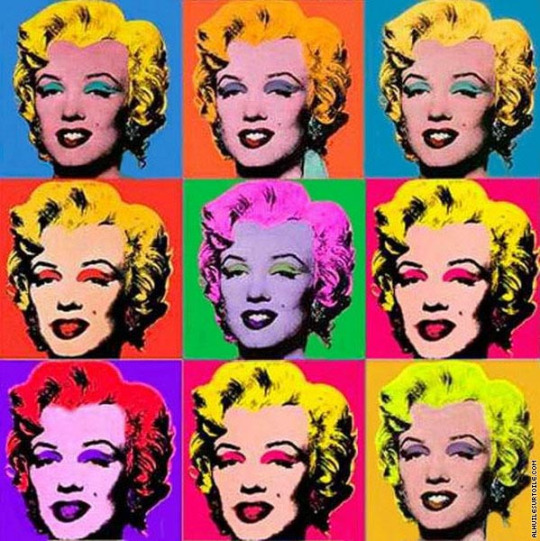

Andy Warhol’s Marilyn Monroe portraits and ‘Death and Disaster’ series.
Abstract artists also inspired the surrealism and themes of radical and grotesqueness in my final piece. Francis Bacon’s expressionist, emotionally charged paintings with often outrageous subject matter and his bold, abstract paintings are what influenced me to reflect the ugly and off-putting issues that surround dog breeding. Therefore, I have painted portraits in my final piece with only a certain amount of detail to make the figures look unnatural and quite freakish to the point that they are uncomfortable to observe. Francis Bacon also used mouths a lot as the focus of his paintings like in ‘Study for a Portrait’ which can look quite abnormal due to the harsh and inconsistent brushstrokes that form the expressionist style. Mouths are very much part of my portraits as each demonstrate a different health problem in each dog, whether it be showing the dogs difficulty in breathing, misshapen mouths, or rabies. As in Francis Bacon’s portraits, I added a lot of light and dark tones to a single colour that formed the background. This was to complement the detail of the foreground but to also create a messier, expressionist style with harsh and free-style brushstrokes also complementing the messy and out of control issue of dog breeding. Bacon also often painted a series of works to capture the most detail and imagery he could out of a single subject, relating to how I have compiled four portraits to emphasise the issue I am trying to present by showing not just one, but many cases of pedigree health defects.

‘Three Studies for a Portrait of George Dyer’

Francis Bacon-Study for a Portrait 1952
Georges Rouaolt

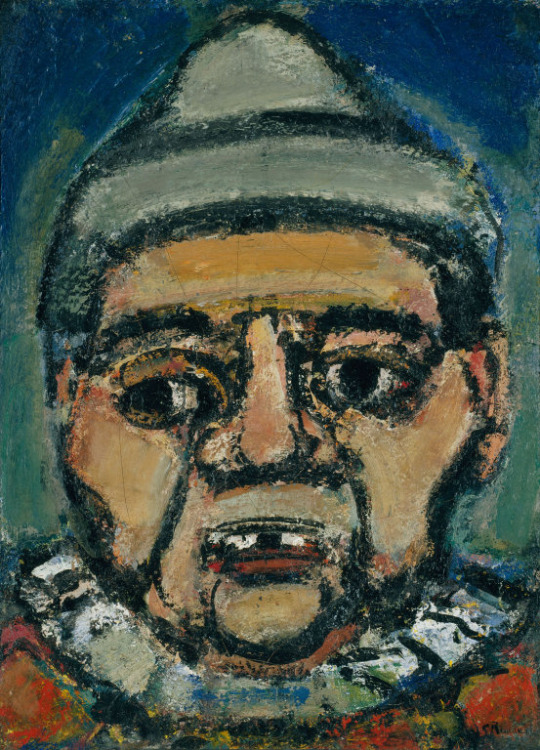
Georges Rouaolt’s expressionistic portraits, like Francis Bacon’s inspired me to paint abstract portraits. Rouaolt’s used the whole canvas to make the portrait as large as possible. I think that idea is effective as the scale of the work can evoke shock and make the work powerful. Rouaolt also complimented light shapes of the face by outlining them in dark shades. This adds to the surrealism theme of his works and when looking at my final piece, particularly the pug, I used an outline of dark brown as I felt that it didn’t have the definition the subject of my work required. Rouaolt’s works have influenced the brash, graphic boldness of my paintings. I also realise from my research that Georges Rouaolt’s portraits were painted to be social criticisms of the time. I have used dark shades of colour ( particularly the backgrounds and dog portraits) in my work to reflect the negative social impact on pedigree dogs health. The Fauvist style which included bright bold sections of colour, shown in Emile Nolde’s ‘Self-Portrait, or in her landscapes including ‘Stormy Sunset’, creates a visually striking piece, something I have tried to include in my work to instantly grab the viewer’s attention.
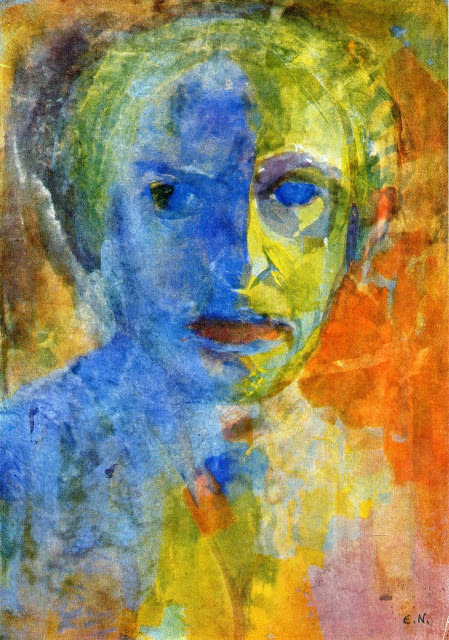
Emile Nolde’s ‘Self Portrait’ (1912)
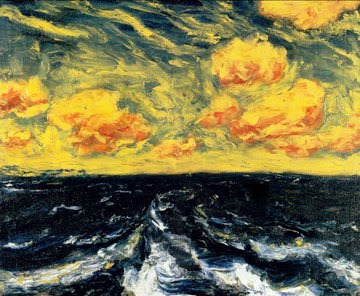
Emile Nolde’s ‘Stormy Sunset’
0 notes
Text
Shar Pei Breed Standard Research
Breed Standard Last updated October 2012
A Breed Standard is the guideline which describes the ideal characteristics, temperament and appearance including the correct colour of a breed and ensures that the breed is fit for function. Absolute soundness is essential. Breeders and judges should at all times be careful to avoid obvious conditions or exaggerations which would be detrimental in any way to the health, welfare or soundness of this breed. From time to time certain conditions or exaggerations may be considered to have the potential to affect dogs in some breeds adversely, and judges and breeders are requested to refer to the Breed Watch section of the Kennel Club website here http://www.thekennelclub.org.uk/services/public/breed/watch for details of any such current issues. If a feature or quality is desirable it should only be present in the right measure. However if a dog possesses a feature, characteristic or colour described as undesirable or highly undesirable it is strongly recommended that it should not be rewarded in the show ring.
General Appearance
Alert, active, compact, short-coupled, squarely built. Dogs larger and more powerful than bitches.
Characteristics
Relatively loose skin, frowning expression, harsh bristly coat.
Temperament
Calm, independent, very affectionate, and devoted to people.
Head and Skull
Relatively large but not disproportionate to the body, skull flat, broad, moderate stop. Length from nose to stop approximately equal to length from stop to occiput. Moderate wrinkle on forehead and cheeks. Muzzle moderately broad and full with no suggestion of tapering. The lips and top of muzzle may be slightly padded. When viewed from front, bottom jaw appears wider than top. Nose large, wide, preferably black but any colour conforming to general coat colour permissible.
Eyes
Dark, medium size, almond-shaped with frowning expression. Amber and lighter colours permissible in paler shades. Function of eyeball or lid in no way disturbed by surrounding skin, folds or hair. Any sign of irritation of eyeball, conjunctiva or eyelids highly undesirable. Free from entropion.
Ears
Very small, rather thick, equilaterally triangular in shape, slightly rounded at tip and set high on the skull with tips pointing towards eyes, set well forward over eyes, wide apart and close to skull. The tips and edges may turn up. Pricked ears highly undesirable.
Mouth
Tongue, roof of mouth, gums and flews: solid bluish-black is preferred. Solid pink tongue undesirable. Dogs with self-coloured pigment and amber or light brown eyes would be expected to have a lavender tongue. Teeth strong, with a perfect, regular and complete scissor bite, i.e. upper teeth closely overlapping lower teeth and set square to the jaws. Padding of lower lip should not be so excessive so as to interfere with the bite.
Neck
Medium length, strong, full; set well on shoulders, with some loose skin under neck permitted, but this should not be excessive.
Forequarters
Shoulders muscular, well laid and sloping. Elbows close to the body. Forelegs straight, moderate length, good bone; pasterns slightly sloping, strong and flexible. Forelegs completely wrinkle free when mature.
Body
Height at withers approximately equal to the length from point of shoulders to point of buttock. Depth of brisket approximately half of height at withers. Chest broad and deep, underline rising slightly under loin; back short, strong. Topline dips slightly behind withers then rises over short, broad loin. Adult dogs should display moderate wrinkling over shoulders and base of tail. Excessive skin on body when mature highly undesirable.
Hindquarters
Muscular, strong; moderately angulated; hocks well let down without excessive wrinkling or thickening.
Feet
Moderate size, compact, toes well knuckled.
Tail
Rounded, narrowing to fine point, base set very high. May be carried high and curved, carried in tight curl, or curved over. Lack of, or incomplete, tail highly undesirable.
Gait/Movement
Free, vigorous and balanced, rear single tracking is normal at a fast trot, stilted gait undesirable.
Coat
Extremely harsh coat straight and off-standing on the body but flatter on the limbs. No undercoat. Length varies from short and bristly, under half an inch (1.25cm) or longer and thicker, between half an inch (1.25cm) and one inch (2.5cm), but still off-standing and harsh to the touch. N.B: no particular coat length within the accepted length should be preferred above the other. Never trimmed.
Colour
All Solid colours except white are acceptable. Frequently shaded on tail and back of thighs with lighter colour.
Size
Height: 46-51 cms (18-20 ins) at withers.
Faults
Any departure from the foregoing points should be considered a fault and the seriousness with which the fault should be regarded should be in exact proportion to its degree and its effect upon the health and welfare of the dog and on the dog’s ability to perform its traditional work.
Note
Male animals should have two apparently normal testicles fully descended into the scrotum.
*Note for prospective puppy buyers
Size – the Kennel Club Breed Standard is a guide and description of the ideal for the breed; the Size as described does not imply that a dog will match the measurements given (height or weight). A dog might be larger or smaller than the Size measurements stated in the Breed Standard.
0 notes
Text
Poodle Breed Standard Research
The Kennel Club
Breed Standard Last updated August 2009
A Breed Standard is the guideline which describes the ideal characteristics, temperament and appearance including the correct colour of a breed and ensures that the breed is fit for function. Absolute soundness is essential. Breeders and judges should at all times be careful to avoid obvious conditions or exaggerations which would be detrimental in any way to the health, welfare or soundness of this breed. From time to time certain conditions or exaggerations may be considered to have the potential to affect dogs in some breeds adversely, and judges and breeders are requested to refer to the Breed Watch section of the Kennel Club website here http://www.thekennelclub.org.uk/services/public/breed/watch for details of any such current issues. If a feature or quality is desirable it should only be present in the right measure. However if a dog possesses a feature, characteristic or colour described as undesirable or highly undesirable it is strongly recommended that it should not be rewarded in the show ring.
General Appearance
Well balanced, elegant looking with very proud carriage.
Characteristics
Distinguished by a special type of clip for show activity and by a type of coat which does not moult.
Temperament
Gay-spirited and good-tempered.
Head and Skull
Long and fine with slight peak. Skull not broad, moderate stop. Foreface strong, well chiselled, not falling away under eyes; cheek bones and muscle flat. Lips tight-fitting. Chin well defined but not protruding. Head in proportion to size of dog.
Eyes
Almond-shaped, dark, not set too close together, full of fire and intelligence. Eye colour see Colour Clause.
Ears
Leathers long and wide, set low, hanging close to face.
Mouth
Jaws strong with perfect, regular and complete scissor bite, i.e. upper teeth closely overlapping lower teeth and set square to the jaws. A full set of 42 teeth is desirable.
Neck
Well proportioned, of good length and strong to admit of the head being carried high and with dignity. Skin fitting tightly at the throat.
Forequarters
Well laid back shoulders, strong and muscular. Legs set straight from shoulders, well muscled.
Body
Chest deep and moderately wide. Ribs well sprung and rounded. Back short, strong, slightly hollowed; loins broad and muscular.
Hindquarters
Thighs well developed and muscular; well bent stifles, hocks well let down; hindlegs turning neither in nor out.
Feet
Tight, proportionately small, oval in shape, turning neither in nor out, toes arched, pads thick and hard, well cushioned. Pasterns strong.
Tail
Previously customarily docked.Docked: set on rather high, carried at slight angle away from the body, never curled or carried over back, thick at root.Undocked: Thick at root, set on rather high, carried away from the body and as straight as possible.
Gait/Movement
Sound, free and light movement essential with plenty of drive.
Coat
Very profuse and dense of good harsh texture. All short hair close, thick and curly. All traditional trims permissible in the show ring and the dogs judged on equal merit, as long as there is sufficient length to demonstrate colour and quality of coat.
Colour
All solid colours. White and creams to have black nose, lips and eye rims, black toenails desirable. Browns to have dark amber eyes, dark liver nose, lips, eye rims and toenails. Apricots and reds to have dark eyes with black points or deep amber eyes with liver points. Blacks, silvers and blues to have black nose, lips, eye rims and toenails. Creams, apricots, reds, browns, silvers and blues may show varying shades of the same colour up to 18 months. Clear colours preferred. Non solid colours are highly undesirable and should be heavily penalised.
Size
Poodles (Standard): over 38 cms (15 ins).
Faults
Any departure from the foregoing points should be considered a fault and the seriousness with which the fault should be regarded should be in exact proportion to its degree and its effect upon the health and welfare of the dog and on the dog’s ability to perform its traditional work.
Note
Male animals should have two apparently normal testicles fully descended into the scrotum.
*Note for prospective puppy buyers
Size – the Kennel Club Breed Standard is a guide and description of the ideal for the breed; the Size as described does not imply that a dog will match the measurements given (height or weight). A dog might be larger or smaller than the Size measurements stated in the Breed Standard.
0 notes
Text
Chihuahua Breed Standard Research
The Kennel Club
Breed Standard Last updated October 2009
A Breed Standard is the guideline which describes the ideal characteristics, temperament and appearance including the correct colour of a breed and ensures that the breed is fit for function. Absolute soundness is essential. Breeders and judges should at all times be careful to avoid obvious conditions or exaggerations which would be detrimental in any way to the health, welfare or soundness of this breed. From time to time certain conditions or exaggerations may be considered to have the potential to affect dogs in some breeds adversely, and judges and breeders are requested to refer to the Breed Watch section of the Kennel Club website here http://www.thekennelclub.org.uk/services/public/breed/watch for details of any such current issues. If a feature or quality is desirable it should only be present in the right measure. However if a dog possesses a feature, characteristic or colour described as undesirable or highly undesirable it is strongly recommended that it should not be rewarded in the show ring.
General Appearance
Small, dainty, compact.
Characteristics
Alert little dog; swift-moving with brisk, forceful action and saucy expression.
Temperament
Gay, spirited and intelligent, neither snappy nor withdrawn.
Head and Skull
Well rounded ‘apple dome’ skull, cheeks and jaws lean, muzzle moderately short, slightly pointed. Definite stop.
Eyes
Large, round, but not protruding; set well apart; centre of eye is on a plane with lowest point of ear and base of stop; dark or ruby. Light eyes in light colours permissible.
Ears
Large, flaring, set on at an angle of approximately 45 degrees; giving breadth between ears. Tipped or broken down highly undesirable.
Mouth
Jaws strong, with a perfect, regular and complete scissor bite, i.e. upper teeth closely overlapping lower teeth and set square to the jaws.
Neck
Slightly arched, medium length.
Forequarters
Shoulders well laid; lean, sloping into slightly broadening support above straight forelegs, set well under chest giving freedom of movement without looseness.
Body
Level back. Body, from point of shoulder to rear point of croup, slightly longer than height at withers. Well sprung ribs, deep brisket.
Hindquarters
Muscular; hocks well let down, with good turn of stifle, well apart, turning neither in nor out.
Feet
Small and dainty, turning neither in nor out; toes well divided but not spread, pads cushioned, fine, strong, flexible pasterns. Neither hare- nor cat-like, nails moderately short.
Tail
Medium length, set high, carried up and over back (sickle tail). When moving never tucked under or curled below the topline. Furry, flattish in appearance, broadening slightly in centre and tapering to point.
Gait/Movement
Brisk, forceful action, neither high-stepping nor hackney; good reach without slackness in forequarters, good drive in hindquarters. Viewed from front and behind legs should move neither too close nor too wide, with no turning in or out of feet or pasterns. Topline should remain firm and level when moving.
Coat
Long Coat: soft texture (never coarse or harsh to touch) either flat or slightly wavy. Never tight and curly. Feathering on ears, feet and legs, pants on hindquarters, large ruff on neck desirable. Tail long and full as a plume.
Colour
Any colour or mixture of colours - but never merle (dapple).
Size
Weight: up to 2.7 kgs (6 lbs), with 1.8 - 2.7 kgs (4 - 6 lbs) preferred.
Faults
Any departure from the foregoing points should be considered a fault and the seriousness with which the fault should be regarded should be in exact proportion to its degree and its effect upon the health and welfare of the dog and on the dog’s ability to perform its traditional work.
Note
Male animals should have two apparently normal testicles fully descended into the scrotum.
*Note for prospective puppy buyers
Size – the Kennel Club Breed Standard is a guide and description of the ideal for the breed; the Size as described does not imply that a dog will match the measurements given (height or weight). A dog might be larger or smaller than the Size measurements stated in the Breed Standard.
0 notes
Text
Poodle Skin Problems Research
Most poodle skin problems result from an underlying hereditary illness. After your vet diagnoses the disease causing the skin issues, systemic treatment can begin. Certain poodle skin problems appear primarily in just one of three breed sizes – toy, miniature and standard, with the latter especially vulnerable to skin disorders.
Sebaceous Adenitis
A problem chiefly with standard poodles, sebaceous adenitis results from inflamed sebaceous glands. Signs of this skin issue include dry, flaking skin, patchy hair loss, matted hair clumps and general skin thickening. Because it can cause itching, affected poodles might scratch incessantly. Secondary infection is common, so the dog might exhibit foul-smelling lesions. While there is no cure for sebaceous adenitis, symptoms might come and go. Your vet might recommend antibacterial shampoos and prescribe antibiotics to fight infections. Topical oils can offer your dog some relief. Poodles diagnosed with sebaceous adenitis should not be bred. Standard poodles are most likely to develop sebaceous adenitis.
Cushing’s Disease
Cushing’s disease, common in poodles, occurs when the adrenal glands produce too much cortisone hormones. The disease also can develop in dogs given excessive amounts of steroids over the long term. Middle-aged to older poodles are most often affected. Symptoms include a dull, dry, flaky coat, along with hair loss. The dog’s skin bruises easily, and pimples can appear. Any wounds can take considerable time to heal. Poodles with Cushing’s disease may exhibit increased drinking and subsequent urination, along with a voracious appetite. A pot belly can develop.
If your poodle is diagnosed with pituitary dependent Cushing’s disease, the most common type, he must take medication to control the condition for the rest of his life. If diagnosed with the adrenal dependent form of the disease, that means he has a tumour on his adrenal gland that requires surgical removal.
Hypothyroidism in Poodles
Hypothyroidism, which occurs when the thyroid glands no longer produce sufficient hormone, is common in the breed. Symptoms often include skin problems, especially thickening or changes in pigment, excessive dryness and hair loss. Other symptoms include lethargy, constant hunger and cold intolerance. Fortunately, once diagnosed via a blood test, a daily thyroid pill – required for life – takes care of the condition.
Pyoderma in Poodles
Pyoderma in poodles usually occurs because of underlying hypothyroidism or Cushing’s disease. Pyoderma, or “pus in the skin,” consists of three basic types. The surface pyoderma, also known as a “hot spot,” causes itching and the affected area usually smells bad. Superficial pyodermas resemble large pimples or boils, while deep pyodermas actually drain pus. Your vet takes a sample of the pyoderma exudate to determine the bacteria involved. While hot spots might respond to topical therapy, superficial and deep pyodermas require oral antibiotics, with the latter type often necessitating a few months of treatment. Your vet likely will prescribe antibacterial shampoos to treat the skin infection.
1 note
·
View note
Photo

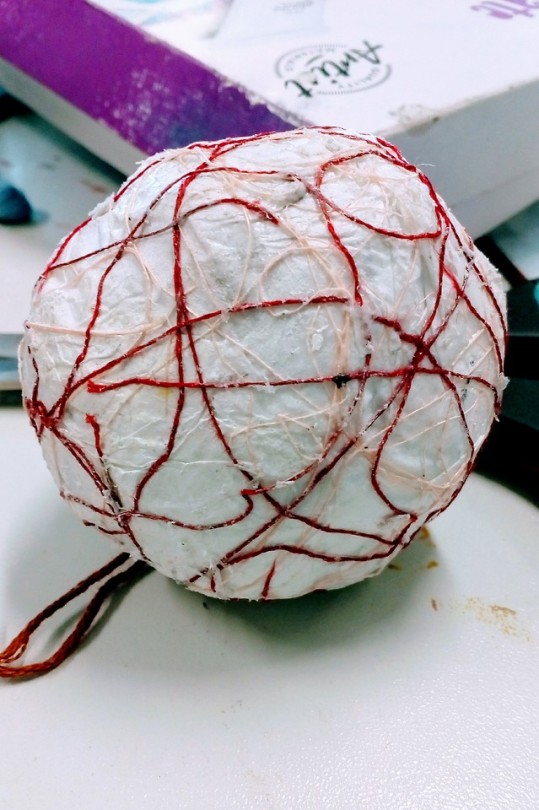



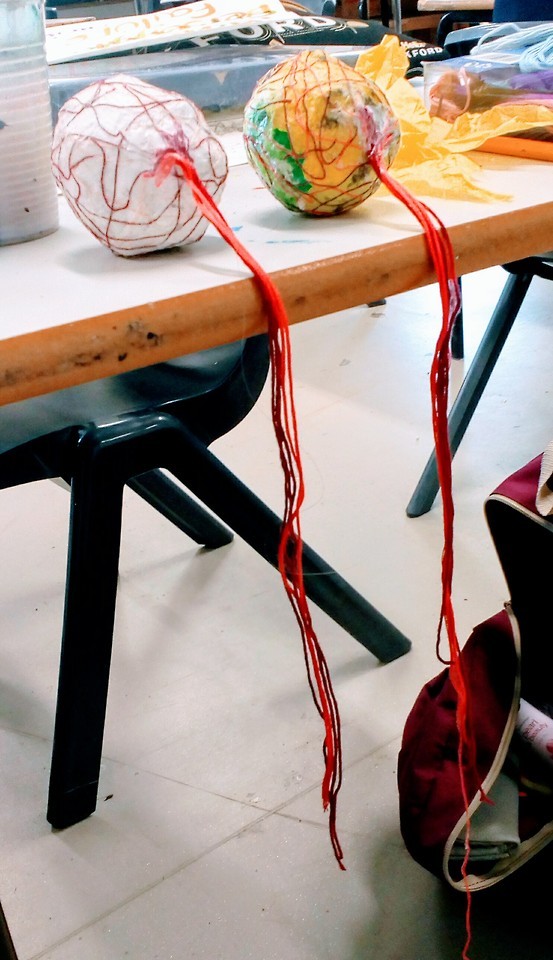
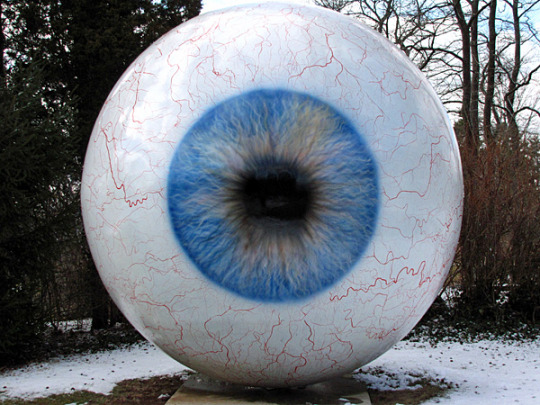
Cataracts and Multifocal Retinal Dysplasia. My two models are inspired by Tony Tasset’s ‘Eye’ located in Laumeier Sculpture Park/
0 notes
Photo

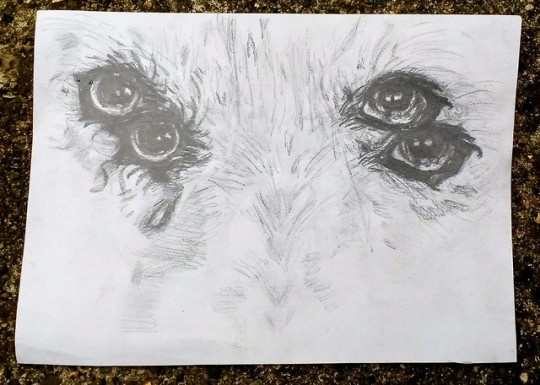


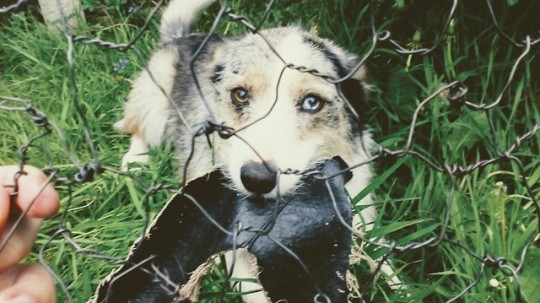
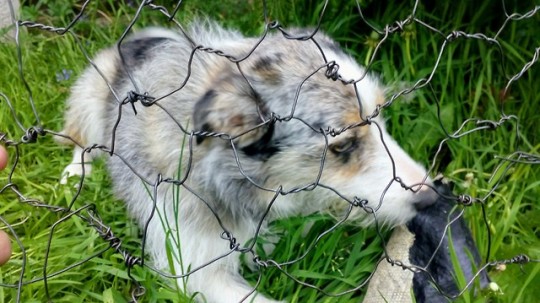
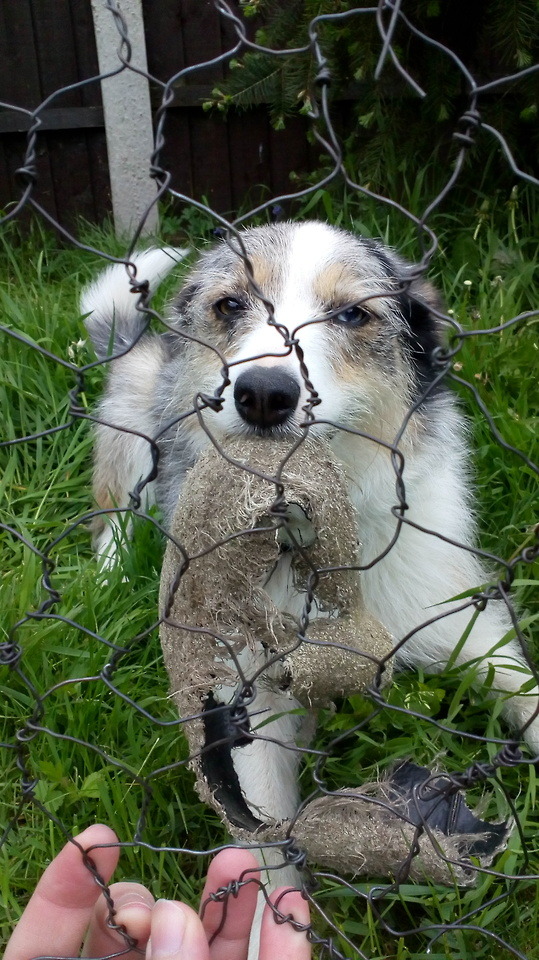
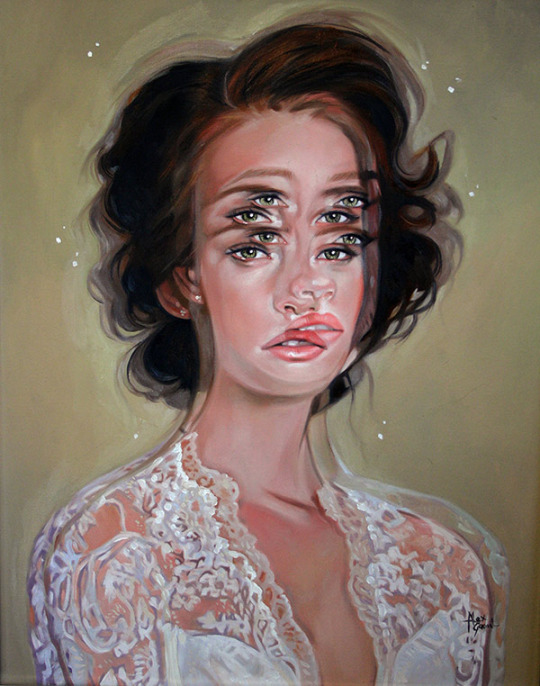
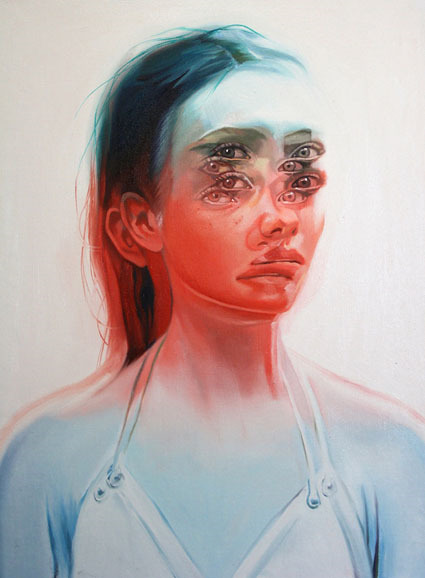
Here, I have experimented with ‘double vision’ in my work, another eye problem suffered by many pedigree dogs. Inspired by the work of Alex Grant, I have drawn from a photograph of my own dog’s eyes, traced over them and then reproduced that image below the original to create the illusion of seeing ‘double’. I thought that using the tracing paper that I roughly sketched on all worked as a way of creating ‘triple vision’. Despite being only rough outlines of the original image, I though it was effective in creating not only ‘triple vision’, but ‘partial sight’ as well, emphasising the detrimental impact inbreeding can have on a dog’s vision.
I then made a model out of wire resembling a piece of a gate to put over the ‘double vision’ piece. This is to show how overbred some pedigree dogs are that so many of them are in dog rescue shelters and kennels, suffering with these health problems. They therefore have no standard of living or quality of life. I put the wire over my own dog’s face just to experiment with how my work looks in trying to create everyday situations. I thought this was successful, as one of the photographs does in my opinion look like it could be an advertisement for a dog rescue charity. However, I will not be using wire again as I had a problem with making the piece as the material is not as malleable as I would like, so many of the shapes I tried to create were messy and uneven. I did however try to resolve this problem by amending the shapes with solid pens and a knife to get more symmetrical shapes. I have concluded that I won’t be using wire again, but it has been interesting and enjoyable working with a new medium.
0 notes

